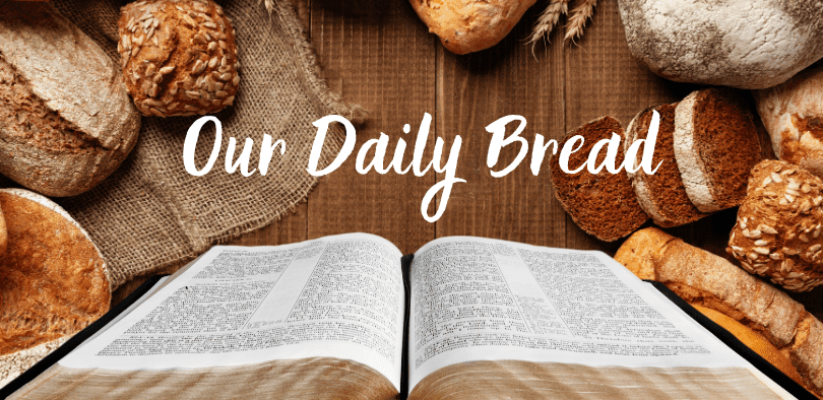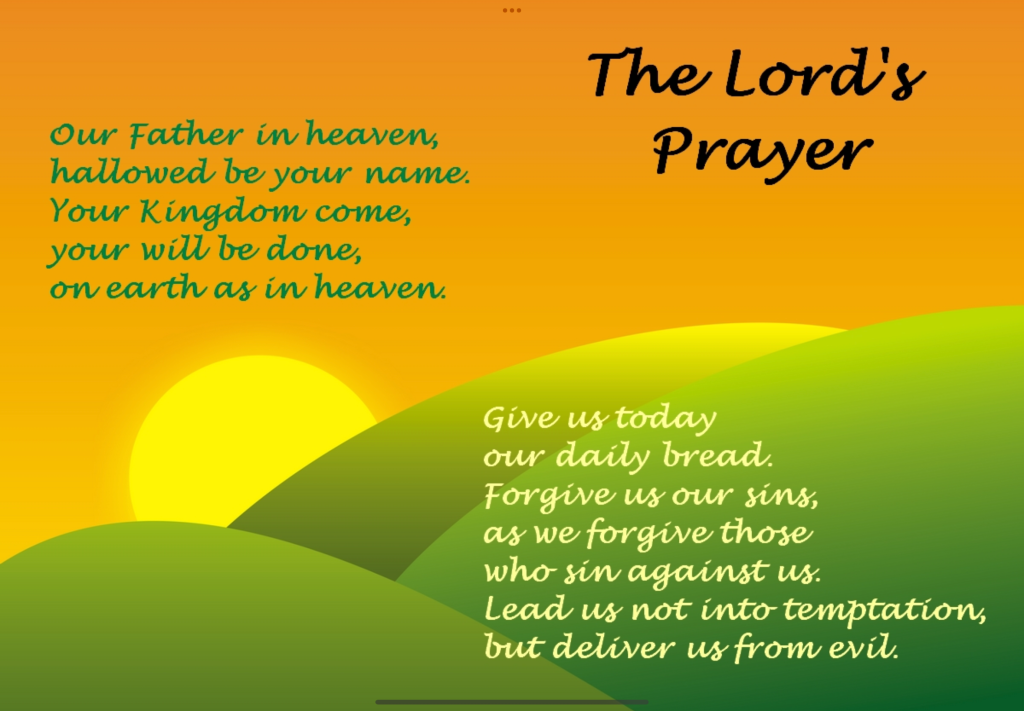In the series of Gospel readings offered by the Revised Common Lectionary, there is a break from the sequential readings from the Gospel of Matthew begun in early January each year. This year—Year A—we began with the early chapters of the Gospel according to Matthew (from 2:1 through to 5:37); but when the season of Lent began, that pattern was interrupted.
We return to Matthew with Matt 9 on the Second Sunday after Pentecost, jumping from where we had left the Gospel back in February, in the middle of the Sermon on the Mount. That means that we have omitted the passage where Jesus says “pray then in this way”, giving his disciples a set of words (6:9–13) that has come to be known as The Our Father (after its opening phrase) or The Lord’s Prayer (after the one who gave it to his disciples). So this week I am posting about this well-known and much-loved prayer. The first post is at
“Give us bread for the day” has often been seen to be evoking the story embedded within the foundational myth (establishing the central identity) of the people of Israel, when the Lord provided manna to the people whilst they journey in the wilderness (Exod 16; Num 11); further reference is made to this manna in additional books of Hebrew scripture (Deut 8:3, 16; Neh 9:20; Ps 78:24).

That gift of manna, striking in the wilderness experience, was also provided to the Israelites when they camped at Gilgal, on the verge of entering into the land of Canaan (Josh 5:10–12). The story has a potency that makes it an essential element in the identity of Israel: it is a nation which trusts in the gracious provisions of God.
Jesus continues that attitude; God is the one who will provide when something is asked for (Mark 11:24; Matt 7:7, 11; 9:38; Luke 10:2; 11:9, 13; John 14:13; 15:7, 16; 16:23). Consistent with that, asking for “bread for the day” is an appropriate prayer to offer.
The next petition raises other questions. Differences in the Greek terms used in the early versions of this prayer point to the matter; is it “forgive us our sins” or “cancel the debts we owe”? On the different words used, see
Of course, forgiveness is part of the “gospel” of Hebrew Scriptures; the claim that God forgives is found in numerous places. Abraham wrangles with God to forgive Sodom (Gen 18:16–33); Moses pleads, successfully, with the Lord to forgive Israel after their rebellion in the wilderness (Num 14:1–25), and less successfully after the incident involving the golden statue of a calf (Exod 32:30–35). Jeremiah foresees that within the new covenant given by God, forgiveness will be offered (Jer 31:34).

A refrain in a number of places is that “the Lord is slow to anger, and abounding in steadfast love, forgiving iniquity and transgression” (sin” (Exod 34:6–8; Num 14:18; Neh 9:17b; Ps 145:8–9; Joel 2:13; Jonah 4:2; see also 2 Kings 13:23; 2 Chron 30:9). King Solomon prays for God to forgive the people (1 Ki 8:33–40; 2 Chron 6:18–40), the psalmist prays for forgiveness (Ps 25:18; 79:9), and so do some prophets (Ezek 16:63; Dan 9:19; Amos 7:2). Jesus’ prayer petition for God to forgive, in the central prayer he taught, continues this motif.
The associated clause of the prayer, instructing us to follow the example of God and forgive the sins of others, also reflects enduring Israelite understandings. Joseph forgives his brothers (Gen 50:15–21), David forgives Abigail (1 Sam 25:26–28, 32–35). Jesus exhorts his followers to forgive seven times (Luke 17:1–4) or seventy times seven (Matt 18:21–22), and is remembered as the one who came to forgive sins (Mark 2:10; Matt 9:6; Luke 5:24; 23:34), and so this clause of the pray is consistent with that.
If the prayer is about asking God to cancel debts,rather than forgive sins, then another theme in Hebrew Scripture is drawn in by Jesus. The release of slaves and the cancelling of debts was meant to be practised in society every fifty years during the year of Jubilee (Lev 25:8–17; see esp. v.13). Luke explicitly signals this theme in the opening speech of Jesus that he alone reports: “the Spirt of the Lord is upon me … to proclaim release to the captives and recovery of sight to the blind, to let the oppressed go free, to proclaim the year of the Lord’s favour” (4:18–19). The reference to “the year of the Lord’s favour” is commonly taken to be an indication of the Jubilee.
The practice of the Jubilee is, however, dubious. The levitical prescriptions appear to be the ideal that the priests hoped for; actual evidence that this was ever implemented in Israelite society is lacking. Indeed, it is suggested that while the people were in Exile, the land of Israel would “lie desolate”, and “enjoy its sabbath years” (Lev 26:34), providing recompense for all those years when “it did not have on your sabbaths when you were living in it” (Lev 26:35).
Nevertheless, Jesus may well be instructing his followers to pray that this will be a reality in society; that the people “shall proclaim liberty throughout the land to all its inhabitants”, and that those who had been taken to work elsewhere would return “to your property and every one of you to your family” (Lev 25:10). His prayer indicates that he wanted his followers to implement this practice in their lives.

The phrases “save us” and “deliver us” introduce the next two petitions. “Save me” or “save us” is the cry of psalmists (Ps 6:4: 7:1; 22:21; 31:2, 16; 44:6; 54:1; 55:16; 57:3; 59:2; 69:1; 71:2–3; 80:2; 86:16; 106:47; 109:26; 119:94, 146; 142:6; 143:9), and most famously in the Hallel psalm, Psalm 118, in the context of various phrases repeated in Christian worship on a regular basis: “This is the day that the Lord has made; let us rejoice and be glad in it. Save us, we beseech you, O Lord! O Lord, we beseech you, give us success! Blessed is the one who comes in the name of the Lord.” (Ps 118:24–26).
Prophets also cry out for God to save them (Isa 25:9; 33:22; 36:18; 37:20; Jer 17:14), as do the elders of Israel (1 Sam 4:3), the people of Israel (1 Sam 7:8), and the kings David (1 Chron 16:35) and Hezekiah (2 Ki 19:19).
“Deliver me” or “deliver us”, likewise, is a prayer addressed to God by Jacob (Gen 32:10), the people of Israel (Judg 10:15), the friends of Daniel (Dan 3:17), and time and time again by the psalmists (Ps 3:7; 6:4; 7:1; 25:20; 31:1, 15; 39:8; 40:13; 43:1; 51:14; 59:1–2; 70:1–2; 79:9; 106:4; 109:21; 119:170; 120:2; 140:1; 144:11). As Ben Sirach prays in the latter stages of his closing poem, “may he he entrust to us his mercy, and may he deliver us in our days!” (Sir 50:24).
“The time of trial” is a phrase found only in this prayer (Matt 6:13; Luke 11:4) and in the prayer which Jesus is said to have prayed in the Garden of Gethsemane (Mark 14:38; Matt 26:41; Luke 22:40, 46). However, the notion of being tested or put on trial is common in scripture. Moses reminds the Israelites of “what the Lord God did to Pharaoh and to all Egypt, the great trials that your eyes saw” as they wandered in the wilderness (Deut 7:18–19; 29:2–3).
Speaking about the righteous, the psalmist asserts that “the Lord will not abandon them to their power, or let them be condemned when they are brought to trial” (Ps 37:33), whilst the poet who wrote Lamentations reflects that in the invasion of Jerusalem the wrathful God “has besieged and enveloped me with bitterness and tribulation” (Lam 3:5), and Jib poetically reflects, “what are human beings, that you make so much of them, that you set your mind on them, visit them every morning, test them every moment?” (Job 7:17–18).
Several commentators point to the similarity between the request in the prayer taught by Jesus for God to “save us in the time of trial” and that found in later rabbinic teaching in the Babylonian Talmud. In the tractate Berakot, one is encouraged to ask the Lord, “Lead me not into error, nor into iniquity, nor into temptation nor into disgrace” (b. Ber. 60b).
Various prophets describe what took place in Israel, as they were invaded and conquered, and what they foresee in the future, when the Day of the Lord comes, in graphic terms that depict intense trials and tribulations. That is picked up in apocalyptic passages in New Testament texts. Being saved from such trials is in view when Jesus indicates that God will ensure that the apocalyptic trials that he foresees will come to an end (Mark 13:20; Matt 24:22). The seer of Patmos assures the church in Philadelphia that “because you have kept my word of patient endurance, I will keep you from the hour of trial that is coming on the whole world to test the inhabitants of the earth” (Rev 3:10).

Likewise, the phrase “the evil one” is absent from Hebrew Scripture, but the notion of evil is present throughout—from the garden of Eden, where Adam and Eve flaunt the ban on their eating fruit from “ the tree of the knowledge of good and evil” (Gen 2:15–17; 3:1–7), through the forty years when Israel,was condemned to “wander in the wilderness for forty years, until all the generation that had done evil in the sight of the Lord had disappeared” (Num 32:13), and the generations under the Judges when “the Israelites did what was evil in the sight of the Lord” (Judg 2:11; 3:7, 12; 4:1; 6:1; 9:23; 10:6; 13:1).
In their debate with Samuel regarding the need for a king in Israel, the people confess “the evil of demanding a king for ourselves” (1 Sam 12:19); this comes to fruition again and again in the following centuries. Under Jeroboam, son of Solomon, his wife prophesies against him, declaring that “you have done evil above all those who were before you” (1 Ki 14:9); under his brother Rehoboam, the people of Judah “did what was evil in the sight of the LORD; they provoked him to jealousy with their sins that they committed, more than all that their ancestors had done” (1 Ki 14:22).
The same formulaic denunciation then condemns almost all of the northern kingdom kings who follow: Nadal at 1 Ki 15:25–26; Baasha at 1 Ki 15:33–34; Zimri at 1 Ki 16:15–20; Omri at 1 Ki 16:25–28; Ahab at 1 Ki 16:29–30, 22:37–40; Ahaz at 1 Ki 22:51–53; Jehoram at 2 Ki 3:1–2; Ahaziah at 2 Ki 8:26–27; Jehoash at 2 Ki 13:10–13; Jeroboam II at 2 Ki 14:23–29; Zechariah at 2 Ki 15:8–12; Menahem at 2 Ki 15:17–22; Pekahaiah at 2 Ki 15:23–26; Pekah at 2 Ki 15:27–31; and Hoshea at 2 Ki 17:1–4. In other words, almost all of the kings of Israel! (Of course, the work comes from those telling the story in the southern kingdom.)
The notion of a personified “evil one” does not emerge until much closer to the time of Jesus. Satan was originally “an adversary” to Balaam (Num 22:22–23), David (1 Sam 29:4; 2 Sam 19:22; 1 Chron 21:1), Solomon (1 Ki 11:14, 23–25) and the high priest Joshua in the time of return from Exile under Darius of Persia (Zech 3:1–10). In Jewish literature in the ensuing centuries—1 Enoch, Jubilees, 2 Enoch—the adversary develops into an evil personage.
Most famously, the accuser from the heavenly court, delegated by God to prosecute the case against Job (Job 1:6–12; 2:2–8), would eventually become Satan, tester of Jesus (Mark 1:13), a fallen heavenly being (Luke 10:18) who is “deceiver of the whole world” (Rev 12:9; 20:2–3), and “the evil one” from whom Jesus instructed that we should pray to be delivered. He thus draws deep from the wells of his Jewish heritage in these petitions—“deliver us … save us”.


